Best of Reaktor User Library november 2.010
Effects
Jeepotronics v1.1
By Jean-Pierre DEVIN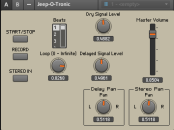
Frippertronics like
This is a frippertronics-like infinite delay.
You can record multiple loops, pan them... the delay is synced to Reaktor's tempo
(or your host DAW tempo as well).
***
optimus prime v3.0 v1.0
By Donald Phillips
Sound Transformer
Add up to 4 effects simultaneously to incoming audio.
Optimus Prime is similar to The Finger in that
1)Effects are triggered by incoming MIDI notes.
2)new effects are added to the end of the effect chain instead of a predetermined routing.
8 FX included - HP, LP or BP filter, pitch shifter, gate, stutter, ringmod, reverse stutter, grain, and bitcrusher.
Improvements over previous versions:
1) Rewritten in core for 50-66% decrease in CPU resources used.
2) LFOs added to automate any of the knobs to create filter sweeps and tape stop effects.
3) Wider array of effects are possible; bitcrusher and ringmod are examples of effects
that were not possible in the previous engine.
4) More flexibility over MIDI controls
***
Repitch 2.1 v4.0
By Shane Higgins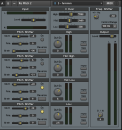
multi band pitch shifter
Newer version of repitch with the band splitter from the multi band expander in the library
Now with pan per band as per request and an additional crossover stage after the pitch shifting
***
RE pitch 3 v1.0
By Shane Higgins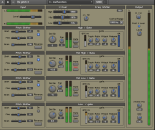
multi band pitch shifter new version
Ok so a few changes. I added another Cross over at the end of the signal chain
to remove overlap between pitch shifts.
There is also a gate on each band as well as a pan per band.
I also added a few more snapshots.
This one is quite cpu hungry because i dont really know what i'm doing ;-)
***
Tape Buster v3.0
By Stefan Knauthe
Magnetic Tape Abuser
Hi, here is another approach to the effect of magnetic tape recording.
It's a simple reverse engineering ensemble based around the Aging Machine
that K.Thom delivered yesterday in his Wave Bouncer ensemble.
Credit also goes to S. Millward for other stages of this unit.
No snaps so far since it is very simple to use.
But i find it a pretty effective way to add some flavour of a broken down
or abused reel to reel tape machine or cassette recorder.
***
Sequencers
UniPat v1.1
By Kim Bostroem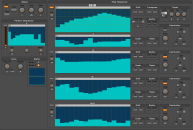
Universal Midi Pattern Sequencer
UniPat is a universal MIDI pattern sequencer for any hardware synthesizer
compatible with CC or NRPN data.
Features:
- Pattern sequencer (max 32 steps)
- 5 step sequencers (max 32 steps)
- Adjustable global Shuffle amount
- Freely definable controllers (CC and NRPN)
- Patterns can be shifted back and forth, raised and scaled up and down
- Copy and paste of patterns
- Additional controls include Tune, Gate duration, and Gate threshold
Hints:
- Enable Info View to get help for individual panel elements.
- Table data are NOT stored with the snapshots but with the entire ensembel.
Therefore modifying the table data has impact on all snapshots using this sequence.
- Copy and paste table data across snapshots easily using the global buffers in the top right corner.
- Only the visible data in the sequence table is affected by shift, scale, raise, copy and paste.
Thus, by varying the length of the sequence table, you can shift, copy or paste parts of the sequence.
***
weird Boehmy neon v2.0
By Bernd Keil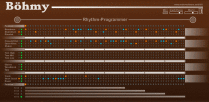
mod rhythm unit
Thanks to Karl F. Meis for Böhmy.
Modifications to WBN:
- coloured switch on performer
- random pitch tunings for each instrument
- de-isolate Vol, Pan, Tuning, Crash-Decay, Master
- random trigger red-switch, to get off rhythm
(sit in front of on/off switch)
- more than 100 presets
you can layer sounds to get accents
if you desire for more ..
take Pannax, here in the user library
***
Synthesizers
MF Auralis v2.0
By Jim Hurley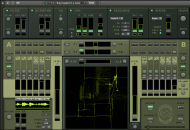
Auralis gets Metaphysical
Download the instructions to get this ensemble.
128 Samples made from Auralis
128 snapshots in Metaphysical Function Stereo
MF with extra resonances and reverbs setting.
Just in time for Halloween!
Enjoy,
Jim Hurley October 31, 2010
PS: This ensemble can play Simon Stockhausen's MF Eternity snapshots,
but it isn't compatible with older Metaphysical Function ensembles.
***
Wave Bouncer v1.0
By Kristian Thom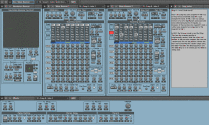
Child of Wave Scanner wants to play with Newtonian Bouncer.
History:
Newtonian Bouncer by CList is one of the few ensembles which had my jaw drop to the floor the first time I saw it in action. There was just something crazy and wonderful about having a physics engine in Reaktor, and an ensemble where you could go like: "I'm just going to turn on the Sun... Oh, and let's change its mass. Hmm, how about inverting gravity, and having the ball fly through a thick soup!"
Ever since I first saw it, I knew I wanted to put it to use in an ensemble. It was just a bit too special to be forgotten and left gathering dust on my hard disk (and in the UL). However, I couldn't really think of any ensemble where it might be musically useful. I was trying to come up with ideas where I would build an ensemble based on the functionality of Newtonian Bouncer, but I couldn't think of anything, so I just forgot about it after a while.
Much later, I wanted to have a go at a new Wave Scanner ensemble. I had for some time wanted to create an alternate Wave Scanner ensemble from scratch. I wanted to use the same basic idea, but change the focus a bit, and have more flexibility with regard to scanner modes.
Anyway, that's when I thought of Newtonian Bouncer again. I realized I had to add some functionality to NB to try and make it a better fit for the Wave Scanner idea.
And so Wave Bouncer was born...
General info:
- The not so good news first: Wave Bouncer can use a fair amount of CPU power, depending on various settings. It can vary as much as 10% between snapshots, so the lowest CPU usage I have had on my admittedly rather old P4 3.2 Ghz PC, was approx. 26% and the highest was 37%. However, most of the snapshots were just below 30%.
- Even though this ensemble is based on my previous Wave Scanner ensembles, I have built it from scratch, firstly because I simply wanted to, and secondly because I also wanted to explore other aspects of the same basic idea. That is why I didn't want to call it Wave Scanner 3. It's more like an alternate version rather than an upgrade or new version.
- The ensemble consists of four instruments (plus an instrument called Snap notes, which are basically a sort of snapshot based tutorial). The main part of the ensemble consists of two Wave Bouncer instruments, each of which features the following:
- 8 oscillators (each with 7 waveforms) that are being "scanned" using various Scanner modes. So, for instance, when you press a key on your MIDI keyboard, sound from the various oscillators will be heard according to the scan position of the note you are playing.
- A polyphonic scan position display gives you visual feedback about the scan position and scan speed of various voices (max. 5 voices in the display). This can sometimes be very helpful with regard to understanding what is going on behind the scenes.
- A filter section shared by all the 8 oscillators, but cutoff frequency and resonance can be set for each oscillator.
- For each of the 8 oscillators, you can also set (in addition to cutoff frequency and resonance) Pitch, Amplitude, Balance, Amplitude Modulation speed, and Aplitude Modulation Depth.
- To the right of the 8 oscillators, are mostly Scanner mode, rate, and clock controls, and some of these are better documented because it might be a bit confusing which Scanner modes can be used with which clocks.
Anyway, if you are confused about what I have written here, I'm sure things will clear up when you try the ensemble. It's the kind of ensemble which you "get" by using it a bit, and which you discover more things about the more you program it.
- All instruments (apart from Snap notes) feature A and B views.
- There are about 20 snapshots, each with accompanying notes in a separate instrument called Snap notes).
The snapshots are not intended to be presets ready to be put in mixes (although you are obviously free to do so). They are rather attempts at showing a bit of the different things that can be done with the ensemble. My guess is that this ensemble is better suited to people who like to program synths, than to musicians simply looking for new sounds, at least in the long run.
- Please select snapshots from the ensemble (where it says "Ens - Wave Bouncer") at the top in the Reaktor UI. (I am not really so used to these multi-instrument ensembles, so there have been a number of times I have selected the snapshot from one of the instruments and wondered why I'm not hearing the snapshot as I created it...)
- My modification of Newtonian Bouncer is documented in its info, so I'll just mention the two most significant changes:
- Repeated auto-fire based on clock rate. For example, you can have the cannon fire every 16th note or every bar or every 4th bar, and so on.
- Wall bounces can be used to drive a sequencer (Bouncequencer), and you can choose how many of the walls you want to activate for the sequencing.
- The Effects instrument might be a bit unusual, so I hope you understand the info for it. Also, I just want to mention that in "Snap 10" (snapshot 13), I give an example of how to "read" the routing knobs.
- I have included a "bonus" ensemble called Wave Bouncer Deluxe. It was something I started on, but never completely finished. I haven't tested it properly, but it should be fully usable, and it has 8 snapshots. The main difference is that there is a separate filter for each of the 8 oscillators, and there is only one Wave Bouncer Deluxe section. It would have used too much CPU power if I had made two sections.
Thanks obviously go to Chris List (CList) for creating the wonderful Newtonian Bouncer.
Er, I think that's it. Enjoy!
